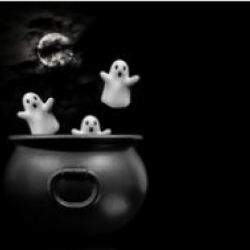This year to celebrate Halloween, Digital Science have compiled their top five spooky scientific research papers.
Supernatural movement
A group of Dutch physicists have studied one of the most puzzling ideas in the universe.
The concept of quantum entanglement — or “spooky action at a distance” —suggests that objects separated by great distances can affect each other’s behavior instantaneously. No less a personage than Albert Einstein famously rejected the notion, which appears to violate core principles of traditional physics. However, Scientists at Delft University of Technology in the Netherlands say they have proved the effect is real, and that simply observing one particle can instantly change another far-away object
The researchers set up two diamonds on opposite ends of the campus — about 1.3 kilometers apart — and blasted each with bursts of microwave and laser energy. This particular experiment came closer than many others to being truly loophole-free. It was published this month in the journal Nature.
Reference: Loophole-free Bell inequality violation using electron spins separated by 1.3 kilometres, B. Hensen, H. Bernien, A. E. Dréau, A. Reiserer, N. Kalb, M. S. Blok, J. Ruitenberg, R. F. L. Vermeulen, R. N. Schouten, C. Abellán, W. Amaya, V. Pruneri, M . W. Mitchell, M. Markham, D. J. Twitchen, D. Elkouss, S. Wehner, T. H. Taminiau&R. Hanson, Nature, October 2015. Altmetric data for this research can be found here
Why do we believe in ghosts?
With the Ghostbusters set to make a comeback, is it time to ask – why do we believe in ghosts? Part of the reason many of us believe in ghosts simply comes down to the way our brains work, according to a study published in Taylor and Francis Online. The research found that having a belief in ghosts can make you more likely to perceive one. In other words, if you’re looking for something, you’re more likely to find it.
Reference: Priming of supernatural agent concepts and agency detection, Michiel van Elk, Bastiaan T. Rutjens, Joop can der Pligt and Frenk van Harreveld, August 2014. Altmetric data for this research can be found here
Why screams are so startling
Screaming is synonymous with scary movies and horror stories but have you ever wondered why the sound of a scream can be so startling? By analyzing YouTube videos and volunteer shriekers, neuroscientist David Poeppel found that the reason is down to the speed in which they increase in volume. This happens too fast for the human brain to perceive as volume increase, resulting in what is called roughness – a startling sound with the ability to cut through background noise.
Reference: Why screams are so startling, Bret Stetka, Scientific American Mind, October 2015. Altmetric data for this research can be found here
Trick, treat or toy?
Bad news for the parents who like to eat their children’s Halloween sweets. According to a research paper published in the Journal of Nutrition Education and Behaviour, children are just as likely to choose toys as the sugary snacks being put on offer.
Reference: Trick, treat, or toy: children are just as likely to choose toys as candy on Halloween, M Schwartz, E Chen, K Brownell, Journal of Nutrition Education and Behaviour, July 2003. Altmetric data for this research can be found here
Scary movie plot holes
If you’re planning to spend Halloween watching ghost, vampire or zombie films, you might want to bear this research in mind. A scientific paper published by Cornell University has disproved certain attributes associated with ghosts, vampires and zombies, including a sudden chill in the presence of a ghost and vampires “turning” humans by feeding on their blood.
Reference: Cinema Fiction vs Physics Reality: Ghosts, Vampires and Zombies, C.J. Efthimiou, S. Gandhi, Cornell University. Altmetric data for this research can be found here







Comments